|
|
|
|
Trigonometry
|
|
|
|
Trigonometric
functions
|
|
Unit of measurement of
angles - a radian (the circular measure)
|
|
The central angle subtended by the arc equal in length to the radius, i.e.
l = r, |
 |
| we call it
radian. |
| Thus, the angle
a = 1° equals in
radians, |
 |
|
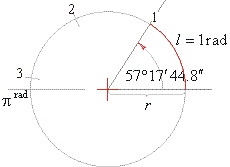 |
|
| or
arc1° =
0.01745329. Arc is abbreviation from Latin
arcus,
(p =
3.1415926535... rad). |
|
|
The unit circle or
trigonometric circle
|
|
A circle of radius r =
1, with the center at the origin
O(0, 0) of a coordinate system, we call the
unit or trigonometric
circle, see the figure below. |
|
The arc of the unit circle that describes a point traveling anticlockwise
(by convention, clockwise is taken to be negative direction) from the initial position
P1(1,
0) on the x-axis, along
the circumference, to the terminal position P
equals the angular measure/distance x
= arad,
in radians.
|
|
An angle is in standard position if its initial side lies along the positive
x-axis. |
|
If we take the positive direction of the x-axis as the beginning of a measurement of an angle (i.e.,
a
= 0rad,
both sides of an angle lie on the
x-axis), and the unit point
P1
as the initial point of measuring the arc, then the terminal side of an angle, which passes through the terminal point
P
of the arc,
rotating around the origin
(in any direction) describes different angles,
and the terminal point P
corresponding arcs, |
| x
= arad
+ k · 2p,
k
= 0, ±1, ±2,
±3,
. . . |
| or
x
= a°
+ k · 360°, k
Î
Z. |
|
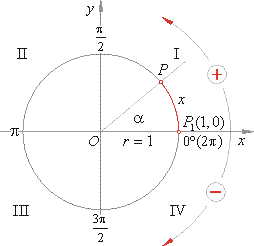 |
|
|
It means that every arc x
ends in the same point P
in which ends the corresponding arc
a.
|
|
Thus, at any
point P
on the circumference of the unit circle end infinite arcs
x = a
+ k ·
2p, which differ by the
multiplier
2p, and any number
x associates only one point
P. |
|
|
Division of the circumference of the unit circle to
the characteristic angles
|
| There
is a common division of the circumference of the unit circle to
the characteristic angles or the corresponding
arcs which are the multipliers of the angles, 30°
(p/
6) and 45°
(p/
4). |
 |
|
|
Definitions of
trigonometric functions
|
|
Let x
be an arc of the unit circle measured counterclockwise from
the
x-axis. It is at the same time the circular measure of the
subtended central angle
a as is shown in the below figure.
|
| In
accordance with the
definitions of trigonometric
functions in a right-angled
triangle, |
| - the sine of an angle
a
(sina)
in a right triangle is the ratio
of the side opposite the angle to the
hypotenuse. |
| - the
cosine of an angle
a
(cosa) in a
right triangle is the ratio of the side adjacent to it to the hypotenuse. |
| Thus, from the
right triangle OP′P,
follows |
| sinx
= PP′
The sine of arc x
is the ordinate of the
arc |
|
endpoint. |
| cosx
= OP′ The cosine of arc
x
is the abscissa of the |
|
arc
endpoint. |
|
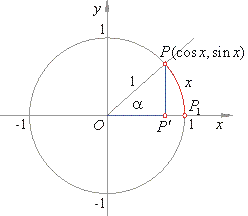 |
|
|
|
|
|
Periodicity of
trigonometric functions
|
|
Functions which have the characteristic to take the same values while their argument changes for all integral
multiples of a constant interval (or a constant increases in amount called increment) we call
periodic functions, and this constant interval we call
period. |
| Hence, we say that trigonometric functions are periodic functions of
x, so that |
|
f (x) = sin x
and f (x)
= cos x of
the period P
= 2p, |
| while
functions, f
(x)
= tan x
and f
(x)
= cot x of
the period P =
p. |
| The periodicity of trigonometric functions show the
identities,
|
| sin
(a
+ k · 2p)
= sin a
and cos
(a
+ k · 2p)
= cos a,
k
Î Z |
|
tan
(a
+ k · p)
= tan a
and cot
(a
+ k · p)
= cot a,
k
Î Z
|
|
|
The table of signs of trigonometric
functions
|
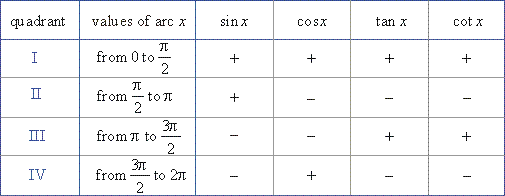
|
|
Trigonometric
functions of negative arcs or angles
|
| We say that arcs x
and x′
are opposite if |
| x
+ x′
= 0 or x′
= -x.
|
| Therefore,
|
 |
 |
|
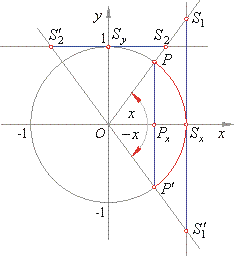 |
|
| Trigonometric
functions of complementary angles
|
Trigonometric
functions of supplementary angles
|
|
|
|
sin
(p
-
x) = sin x,
|
tan
(p
-
x) = - tan
x
|
|
cos
(p
-
x) = - cos
x, |
cot
(p
-
x) =
- cot x
|
|
|
|
Trigonometric
functions of arcs that differ on p/2
|
Trigonometric
functions of arcs that differ on p
|
| sin
(p/2
+ x) = cos x, |
tan
(p/2
+ x) = -
cot x
|
| cos
(p/2
+ x) = -
sin
x, |
cot
(p/2
+ x) = -
tan x
|
|
|
sin
(p
+ x) = -
sin
x, |
tan
(p
+ x) = tan
x
|
|
cos
(p
+ x) = -
cos
x, |
cot
(p
+ x) = cot
x
|
|
|
|
Trigonometric
functions of arcs whose
sum is 2p
|
| The
right figure shows relations between sides of the congruent
right-angled triangles as
follows, |
| PxP′
= - PxP
=> sin
(2p
-
x) = -
sin
x
|
|
OPx
= cos (2p
-
x), cos
(2p
-
x) = cos
x
|
| SxS1′
= -S
xS1
=> tan
(2p
-
x) = -
tan
x
|
| SyS2′
= - SyS2
=> cot
(2p
-
x) = -
cot
x
|
|
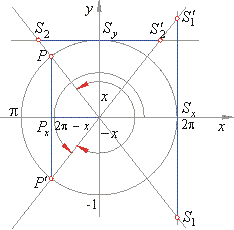 |
|
|
|
|
|
|
|
|
|
|
|
|
|
|
|
|
|
|
|
|
|
|
|
|
|
|
|
|
Contents
E
|
|
|
|
|

|
|
|
|
|
|
Copyright
© 2004 - 2020, Nabla Ltd. All rights reserved.
|
|
|